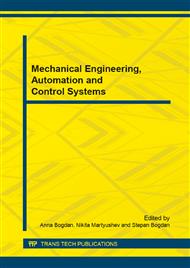[1]
S.Q. Guo, Densification of ZrB2-based composites and their mechanical and physical properties: A review, J. of the European Ceramic Society. 29 (2009) 995–1011.
DOI: 10.1016/j.jeurceramsoc.2008.11.008
Google Scholar
[2]
H. Fu., Y. Lu, W Liu, Pressure effects on elastic and thermodynamic properties of ZrB2, J Mater. Sci. 44 (2009) 5618–5626.
DOI: 10.1007/s10853-009-3791-2
Google Scholar
[3]
F. Monteverde, A., Bellosi, S. Guicciardi, Processing and properties of zirconium diboride-based composites, J. of the European Ceramic Society. 22 (2002) 279–288.
DOI: 10.1016/s0955-2219(01)00284-9
Google Scholar
[4]
J.J. Melendez-Martınez, A. Domınguez-Rodrıguez, F. Monteverde, C. Melandri, G. de Portu, Characterisation and high temperature mechanical properties of zirconium boride-based materials, J. l of the European Ceramic Society. 22 (2002) 2543–2549.
DOI: 10.1016/s0955-2219(02)00114-0
Google Scholar
[5]
I.A. Stepanov, V.A. Skripnyak, S.P. Andrietz, et. al. Investigation of compaction compacting nanostructured zirconium diboride ceramics at the elevated-temperature, Nuclear physics and engineering, 2 (2011) № 31–10.
Google Scholar
[6]
V.V. Skripnyak, E.G. Skripnyak, V.A. Skripnyak, and I.K. Vaganova, Computer simulation of fracture quasi-brittle ceramic nanocomposites under pulse loading, Proc. 11th. World Congress on Computational Mechanics (WCCM XI), 5th. European Congress on Computational Mechanics (ECCM V), 6th. European Congress on Computational Fluid Dynamics (ECFD VI), Eugenio Oñate, Xavier Oliver and Antonio Huerta (Eds. ), CIMNE Publ., Barselona, Spane. IV (2014).
DOI: 10.7712/100016.1819.11114
Google Scholar
[7]
A. M. Rajendran, Modeling the impact behavior of AD85 ceramic under multiaxial loading, Int. J. Impact Engng, 15 (1994) 6749-768.
DOI: 10.1016/0734-743x(94)90033-h
Google Scholar
[8]
D.E. Grady, Shock-wave compression of brittle solids, Mechanics of Materials. 29 (1998) 181-203.
DOI: 10.1016/s0167-6636(98)00015-5
Google Scholar
[9]
N.K. Bourne, The relation of failure under 1D shock to the ballistic performance of brittle materials International, J. of Impact Engng. 35 (2008) 674–683.
DOI: 10.1016/j.ijimpeng.2007.08.001
Google Scholar
[10]
A.M. Bragov, Yu.V. Petrov, B.L. Karihaloo et. al, Dynamic strengths and toughness of an ultra high performance fibre reinforced concrete, Engineering Fracture Mechanics. 110 (2013) 477–488.
DOI: 10.1016/j.engfracmech.2012.12.019
Google Scholar
[11]
A.M. Bragov, P. Demenko, L. Kruszka, A.K. Lomunov, Mechanical behaviors of cement based materials at high rates of strain, J. Phys. IV 110 (2003) 225-230.
DOI: 10.1051/jp4:20020698
Google Scholar
[12]
Yu.V. Petrov, B.L. Karihaloo, V.V. Bratov, and A.M. Bragov, Multi-scale dynamic fracture model for quasi-brittle materials, Int. J. of Engng Sci. 61 (2012) 3–9.
DOI: 10.1016/j.ijengsci.2012.06.004
Google Scholar
[13]
E.G. Skripnyak, V.A. Skripnyak, I.K. Vaganova, A.S. Yanyushkin, et. al. Mechanical properties of nanostructured ceramics based on zirconium diboride, Izvestiya Vuzov. Physica, (in Ruassian), Vol. 55, N 7/2 (2012) 119-123.
DOI: 10.1063/1.4971628
Google Scholar
[14]
E. G. Skripnyak, V.A. Skripnyak, and V. V. Skripnyak, Fracture of nanoceramics with porous structure at shock wave loadings, Shock Compression of Condensed Matter. AIP Conf. Proc. vol. 1426 (2012) 965 -970.
DOI: 10.1063/1.3686485
Google Scholar
[15]
E.G. Skripnyak, V.V. Skripnyak, I.K. Vaganova, and V.A. Skripnyak, Fracture of Ceramic Materials under Dynamic Loadings. Proc. 19th European Conf. on Fracture (ECF19), Kazan, Russia. (2012) 639.
DOI: 10.7712/100016.1819.11114
Google Scholar
[16]
G. R. Johnson, , and T. J. Holmquist, Response of boron carbide subject to large strains, high strain rates and high pressures, J. Appl. Phys. 85 (1999) 8060–8073.
DOI: 10.1063/1.370643
Google Scholar
[17]
A.N. Parshikov, S.A. Medin, I.I. Loukashenko, and V.A. Milekhin, Improvements in SPH Method by means of interparticle contact algorithm and analysis of perforation tests at moderate projectile velocities, Int. J. Impact Eng. 24 (2000) 779-796.
DOI: 10.1016/s0734-743x(99)00168-2
Google Scholar
[18]
Parshikov A.N., Medin S.A., Smoothed particle hydrodynamics using interparticle interparticle contact algorithms, J. Comp. Phys. 180 (2002) 358-382.
DOI: 10.1006/jcph.2002.7099
Google Scholar
[19]
D. E. Wiley, W. R. Manning and O. Hunter, JR. Elastic properties of polycrystalline TiB2 ZrB2 and HfB2 from room temperature to 1300°K, J. of Less-Common Metals. 18 (1969) 149-157.
DOI: 10.1016/0022-5088(69)90134-9
Google Scholar
[20]
S.S. Batsanov, Effects of explosions on materials: Modification and synthesis under high-pressure shock compression. Springer, (1994).
Google Scholar
[21]
Physical values. Handbook. Eds. By Babichev, A.P., Bratkovskii, A.M. et al. Moscow. Energoatomizdat, (1991).
Google Scholar
[22]
W.X. Zhang, T.J. Wang, X. Chen, Effect of surface/interface stress on the plastic deformation of nanoporous materials and nanocomposites, Int. J. of Plasticity. 26 (2010) 957-975.
DOI: 10.1016/j.ijplas.2009.12.002
Google Scholar
[23]
I.A. Ovid'ko, Cracks nucleation in nanomaterials at high-speed and quasistatic modes deformations materials, Physics and Mechanics. 12 (2011) 76-101.
Google Scholar


